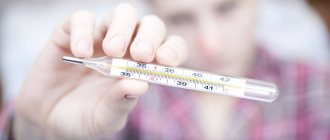36.6 is not a constant body temperature of a healthy person; if you monitor it throughout the day, this value will fluctuate slightly. The lowest result, about 36 degrees, will be at the time of morning sleep. If a person is hot after physical activity, the temperature may rise slightly
Body temperature is affected by heat, humidity, and too warm clothing. Women experience a slight jump in temperature (by half a degree) on certain days of the menstrual cycle. But this will be a one-time increase. A cause for concern may be an increase in temperature from 37.2 to 37.9 over a period of more than a month - this is a low-grade fever.
If a low-grade fever lasts more than two weeks, and is accompanied by symptoms such as fatigue, poor sleep, shortness of breath, then you should not delay seeing a therapist. Often, a low-grade fever signals a problem in the body when other symptoms have not yet appeared.
Thermoregulation in the body
For normal human life it is necessary that heat exchange be carried out constantly. It depends on the characteristics of the organism and on the presence of various reflex stimuli, and changes can have an effect even if the ambient temperature remains unchanged.
Violation of thermoregulation
First of all, such violations can occur as a result of exposure to external or internal factors. For example, internal diseases include various types of diseases.
The main symptoms can be considered:
- chills;
- chills, as a result of hyperkinesis - when involuntary muscle contractions occur;
- as a result of hypothermia - the consequences of hypothermia;
- as a consequence of hyperthermia - in case of overheating of the body.
The main causes of thermoregulation disorders are:
- congenital or acquired defect of the hypothalamus. It can negatively affect the functioning of many internal organs, including body temperature itself;
- climate change. This external factor is capable of influencing body temperature as a result of adaptation of the body;
- alcohol abuse;
- a consequence of processes associated with aging;
- various mental disorders.
Tests and diagnostics
If the patient has a low-grade fever, the medical history is carefully studied: contact with infectious patients, environment, travel abroad, contact with animals, surgical interventions the day before, concomitant diseases. Diagnosis begins with a search for infectious diseases, in which fever is the main symptom.
- Pulmonary and extrapulmonary tuberculosis , brucellosis - to diagnose the latter, Burnet's test and Wright's reaction . To diagnose tuberculosis, an x-ray of the lungs is performed in two projections, a Mantoux test , sputum and urine culture to detect Mycobacterium tuberculosis. Survey radiography of the abdominal cavity and ultrasound of the abdominal cavity in case of tuberculous intestinal lesions determine calcified mesenteric lymph nodes and calcifications.
- Markers of viral hepatitis .
- Tumor markers.
- Bacteriological blood culture for sterility.
- Parasitic panel.
- Bacteriological culture of stool for dysbacteriosis and opportunistic flora.
- Fiberoptic bronchoscopy.
- Conoscopy and biopsy of the intestinal mucosa.
- MRI of the small and large intestine with intravenous contrast.
- Esophagogastroduodenoscopy with helpil test (test for the presence of Helicobacter pylori ).
- MRI of the chest, abdominal cavity and retroperitoneal space for suspected cancer.
- Ultrasound of the gallbladder.
- Cholecystography.
- Ultrasound of the urinary tract plus urine tests for the presence of bacteria, general urine analysis and Nechiporenko.
- MR cholangiopancreatography.
- If necessary, liver puncture.
- Bone marrow aspiration biopsy.
Increased body temperature
One of the serious signs of pathology in the body is an increase in body temperature. If numbers between 36.5 - 36.9 C are considered normal, then its rise is a signal from the body that an infection or virus has entered it and inflammation has begun. Doctors recommend treating this symptom as:
- the ability of your immune system to begin fighting various irritants;
- about the onset of various disturbances in the normal functioning of internal organs, as well as body tissues.
It is for this reason that it is worth considering the various factors and causes of body temperature fluctuations.
Causes of elevated body temperature
If you have a fever, do not immediately panic and start swallowing pills or calling a doctor. It is worth knowing that some causes of elevated temperature do not pose a danger to humans. Let's look at what you should pay attention to.
Non-dangerous causes include symptoms that will go away on their own:
- if the temperature rise occurs in the evening. Very often, it is at this time that it can rise 0.5-1 degrees above normal;
- as a result of emotional or physical stress. They will increase blood circulation, and with it heat exchange will increase;
- during ovulation in women. Often before the start of the menstrual cycle, hormonal surges are possible, and with this the body temperature rises;
- as a consequence of thermal loads. The presence of a body temperature of 37 and above can manifest itself as a result of eating hot food, visiting a bathhouse or sauna, taking a bath, or after sunbathing.
And now it’s worth talking about the pathological causes that can cause dangerous diseases:
- development of acute or chronic infections;
- various viral diseases, including influenza or ARVI;
- all cases of inflammation or swelling;
- for diseases of the respiratory system;
- if there are disorders of the thyroid gland;
- in case of injury to joints and muscles;
- during the course of a sexually transmitted disease.
Symptoms of elevated body temperature
It is worth saying that a significant increase in temperature will be felt by the person himself. The main symptoms include:
- feeling tired and weak;
- chills appear. Moreover, the greater the heat, the stronger the chill will be;
- the appearance of headache;
- the appearance of body aches. The joints, muscles and fingers are most often affected;
- the person begins to feel cold;
- burning and dry eyes appear;
- the mouth feels dry;
- Appetite may decrease or disappear altogether;
- increased heart rate, arrhythmia may appear;
- sweating increases or, conversely, dry skin.
How and when to bring down a high fever in an adult
Body temperature above 38.5C should be of particular concern. And yet, doctors recommend starting to bring down the temperature with medications when it reaches 38C.
But you should focus, first of all, on your general well-being. If the high temperature is poorly tolerated, unbearable aches, chills, confusion, physical discomfort, vomiting, dizziness are felt, then the temperature should be brought down immediately.
But it also happens that even a high temperature occurs with barely noticeable discomfort, then you should focus on the thermometer mark and, if it exceeds 38.5, take an antipyretic drug.
During fever and throughout the entire period of illness, it is important to drink as much fluid as possible. Through the excretory system, it promotes the rapid elimination of bacteria and viruses and their metabolic products - toxins. As a result, you will recover faster from a high temperature.
If there is a need to bring down the temperature, it is worth adding antipyretic drugs. It is better to give preference to single-component products. Adults are recommended to take paracetamol or ibuprofen based products. The use of multicomponent drugs, where paracetamol or ibuprofen are only part of the composition, should be used in extreme cases. And even more so, exclude the joint use of both.
Pathogenesis
Normal temperature is maintained by a balance between heat transfer and heat generation. The amount of heat generated per day must be equal to the amount of heat released. An imbalance of heat exchange causes an increase in temperature to subfebrile levels. The pathogenesis of inflammatory fever is based on the effect of bacterial and viral pyrogens on the thermoregulation center. Most often, a viral-bacterial infection gives rise to a violation of heat exchange, as a result of which heat is retained in the body.
fibrinogen levels and other inflammatory markers increase. Exogenous pyrogens include antigens, bacteria, viruses, and fungi. Exogenous pyrogens do not irritate the thermoregulation center, but stimulate the synthesis of endogenous pyrogens in the body. Endogenous pyrogens are produced by macrophages, neutrophils, monocytes, and some tumors. The period from the entry of pyrogens into the body until the development of the reaction varies: from several minutes when exposed to endotoxins, to a long time when exposed to a bacterial infection. In the absence of inflammatory processes in the body, neurogenic or neuroendocrine mechanisms of thermoregulation play a role in the development of low-grade fever. In patients with fever, the function of the adrenal cortex is impaired and the immune system is suppressed.
What not to do at high temperatures
You should react to an elevated temperature without panic, but with special care.
It is not recommended to bring it down in the first minutes after the increase; you need to let the body cope with the temperature on its own. At this time, the body’s defenses are mobilized and pathogens of various diseases die. But even when lowering the temperature, you should not strive for 36.6. In the first days of illness, this is unlikely to be achieved. Rubbing, especially with vinegar or alcohol solutions, is not recommended. However, this practice still exists at home. If a patient with a high fever is pale and his limbs are cold to the touch (so-called white hyperthermia), then any rubbing is contraindicated for him and, in addition to antipyretics, antispasmodics are recommended. The fact is that cold extremities are caused by vasospasm. And in this case, cold rubbing with vinegar or alcohol-containing liquids can only worsen the situation with the blood vessels.
Wiping with vinegar is not indicated for adults and children with respiratory manifestations of the disease or chronic pathologies of the respiratory system. Vapors can worsen the patient's condition and affect the breathing process. Also, intolerance to vinegar or alcohol, as well as the presence of damage and irritation of the skin, are contraindications to rubbing.
At high temperatures, it is not recommended to eat rich, fatty foods and sugar. An increase in glucose levels in the body reduces the number of white blood cells, which are responsible for destroying infected cells. Which can harm the process of fighting bacteria and viruses. And fatty foods create additional stress on digestion and the body devotes some of its energy to this process, instead of fighting the enemy.
Speaking about drinking liquid at a fever, it should be noted that hot drinking is strictly contraindicated! Especially coffee. Caffeine causes dehydration. A hot drink warms up the body even more. Only warm fruit drinks and herbal teas.
Forecast
The prognosis depends on the cause of low-grade fever. In most cases, it is possible to determine the cause of the increase in temperature and successfully treat it.
With functional disorders of the central nervous system with impaired heat exchange, it is also possible to cope with the problem and achieve a good prognosis in terms of recovery. Treatment, psychotherapy and a correct lifestyle restore impaired heat exchange. Only a number of diseases ( osteomyelitis , oncological and oncohematological diseases, tuberculous meningitis , rheumatoid arthritis , scleroderma , AIDS, Crohn's disease , ulcerative colitis ) have an unfavorable prognosis for recovery, and sometimes even for life.
Reduced body temperature
Like high temperatures, low temperatures also indicate problems. Especially if it lasts for a long time. This leads to rapid fatigue, loss of mood, weakness of the body, etc.
Causes of low body temperature
A decrease in temperature is observed:
- with low hemoglobin;
- in case of internal bleeding;
- during pregnancy;
- if there are problems with blood vessels;
- for diabetes;
- with pathology of the adrenal glands;
- during brain tumors;
- with asthenic syndrome;
- during skin lesions;
- as a result of seasonal ARVI;
- in case of intoxication;
- as a consequence of hypothermia;
- with hypothermia.
Symptoms of low body temperature
Symptoms include:
- weakness;
- drowsiness;
- apathy;
- chills;
- feeling of cold.
List of sources
- Belaya I.E., Dobrin B.Yu., Chizhevskaya I.N. and others. Fever syndrome in therapeutic practice // Ukr. therapeutic journal - 2012. - No. 1. — P. 119-125.
- Bogomolov B.P., Desyatkin A.V. Fever as the most important symptom of infectious and non-infectious diseases // Clinical Medicine - 2007. - No. 1. - T.85. — P.4-8.
- Mironenko T.V. Neurological aspects of low-grade fever // Journal of practical medical treatment - 2006. - No. 2. - pp. 11-14.
- Bryazgunov I.P. Long-term low-grade fevers in children (clinic, pathogenesis, treatment). – M.: MIA LLC, 2008. 240 p.
- Yulish E.I., Chernysheva O.E., Soroka Yu.A. Long-term low-grade fever in children. Possible causes and approaches to therapy. Current issues in pediatrics 2011; 1(35): 67–72.
Psychogenic causes
Low-grade fever, in fact, is a manifestation of an excessively rapid metabolism, which is also influenced by the psyche. Stress, neuroses, and strong emotional experiences, especially in people suffering from hypochondria, can lead to an increase in body temperature. To diagnose psychogenic abnormalities, special questionnaires have been created (Hospital Depression and Anxiety Scale, Emotional Excitability Scale, Beck Scale) to test mental stability. When the diagnosis is confirmed, the patient is offered psychotherapeutic assistance and is also prescribed sedatives.
Source: depositphotos.com
Iron-deficiency anemia
Iron deficiency anemia, which can be caused by poor nutrition, chronic bleeding, diseases of the gastrointestinal tract, pregnancy, is an ailment that is often accompanied by low-grade body temperature. In addition, the disease is accompanied by dizziness, thinning hair and nails, dry skin, drowsiness, decreased immunity, and loss of strength. Lack of iron in the blood can usually be corrected with 2-3 months of treatment, but you should be aware that anemia can be an indicator of serious medical problems.
Source: depositphotos.com
Helminthiasis (helminthic infestation)
A slight increase in temperature along with increased fatigue and weakness are signs of parasitic infections. Low-grade fever occurs as a result of intoxication of the body with waste products of worms and can be combined with digestive disorders, flatulence, drowsiness, and emaciation (especially in the elderly and children). In advanced cases, helminthiasis causes serious illnesses, including intestinal obstruction, biliary dyskinesia, damage to the kidneys, liver, eyes, and brain, so it is important to identify the disease at an early stage. As a rule, one or two courses of anthelmintic drugs are enough for complete recovery.
Source: depositphotos.com
HIV infection
A body temperature of 37-38 °C, along with pain in the joints, muscles, rash, and swollen lymph nodes, may be a sign of an acute period of HIV infection, causing damage to the immune system. A currently incurable disease makes the body defenseless against any infections - even such harmless ones (not involving death) as candidiasis, herpes, ARVI. The latent (asymptomatic) period of HIV can last up to several years, however, as the virus destroys the cells of the immune system, the symptoms of the disease begin to appear in the form of candidiasis, herpes, frequent colds, bowel movements and low-grade fever. Timely detection of HIV will allow the carrier to monitor their immune status and, with the help of antiviral treatment, reduce the level of virus in the blood to a minimum, preventing life-threatening complications.
Source: depositphotos.com











